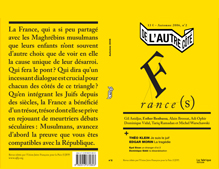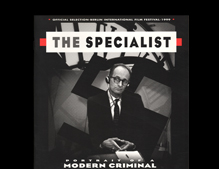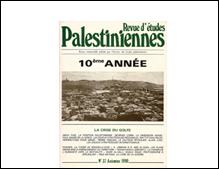-
Proposal for a visual media exhibition
with the participation of students of the Master of Film at the Dutch Film Academy, Amsterdam -
Get my films
Buy DVDs online at www.momento-films.com -
IZKOR
slaves of memory
Documentary film | 1990 | 97 min | color | 16mm | 4:3 | OV Hebrew ST -
Common Archive Palestine 1948
web based cross-reference archive and production platform
www.commonarchives.net/1948 - Project in progress - -
Montage Interdit [forbidden editing]
With professors Ella (Habiba) Shohat and Robert Stam / Berlin Documentary Forum 2 / Haus der Kulturen der Welt / June 2012 -
Route 181
fragments of a journay in Palestine-Israel
Documentary film co-directed with Michel Khleifi | 2003 | 272 min [4.5H] | color | video | 16:9 | OV Arabic, Hebrew ST
-
The Specialist
portrait of a modern criminal
Documentary film | 1999 | co-author Rony Brauman | 128 min | B/W | 4:3 | 35 mm | OV German, Hebrew ST -
Jaffa
the orange's clockwork
Documentary film | 2009 | 88 min | color & B/W | 16:9 | Digital video | OV Arabic, Hebrew, English, French ST
-
Montage Interdit
www.montageinterdit.net
Web-based documentary practice. A production tool, archive and distribution device | project in progress
-
Common State
potential conversation [1]
Documentary film | 2012 | 123 min | color | video | 16:9 split screen | OV Arabic, Hebrew ST -
Towards a common archive
testimonies by Zionist veterans of 1948 war in Palestine
Visual Media exhibition | Zochrot Gallery (Zochrot visual media lab) | Tel-Aviv | October 2012 - January 2013
-
I Love You All
Aus Liebe Zum Volk
Documentary film co-directed with Audrey Maurion | 2004 | 89 minutes | b/w & color | 35mm | OV German, French ST
press
Route 181 by Dennis Harvey (Variety USA)
04.05.2004
A collaboration between Israeli helmer Eyal Sivan and Palestinian Michel Khleifi, “Route 181” spends 4 1/2 hours traveling borders originally set by the United Nations in 1947 to partition Palestine into two states. En route, a variety of people are met, repping myriad ethnicities, personal histories and political stances. Filmmakers’ leanings are cIear - they oppose the occupation, and consider Israel’s story one of monumental injustice toward the local Arab populace. Tacit viewpoint will make broadcast exposure difficuIt to secure in many territories, limiting aud for this worthy (if leisurely) addition to the already large body of docus on the subject. ln fact, pic was already puIled from planned screenings at Cinema du Reel fest in Paris after its November airing on the ARTE channel stirred controversy, incIuding concerns it might foster anti-Semitism.
Actually, while “Route 181” does offer a fairly damning appraisal of Israel as an aggressor within its own borders toward Arab residents, the directors’ focus on individuals humanizes the conflict, lending an air of embattled poignancy and occasional humor that crosses ideological borders.
Taken out of context, some sequences could certainly stir ire - perhaps worst is the first, in which two Israeli Jewish foremen spew racist doggerel. But over docu’s epic course, these recede into a continuum of viewpoints that encompass extremes on both sides but more often reveal overlapping disillusionment in the middle.
Helmers and skeleton crew spent two months in summer 2002 traveling by car along those U.N. Resolution 181 lines, which gave 56% of Palestine terrain to the Jewish minority, remainder to the Arab majority - an act that led to the first Arab-Israeli war, and all conflicts since.
“Route 181” is, very simply, a road diary, according more or less equal weight to every stop. These include visits to numerous museums commemorating Israel’s short history (whereas ail traces of Arab villages that once existed in numerous sites have been erased), elaborate weddings both Jewish and Muslim, chats with tourists and local residents, and, of course, many halts at military checkpoints.
Pic is divided into three 90 minute “legs” - “The South” goes from port city Ashod to frontiers of the Gaza Strip ; “The Center” from Lod to Jerusalem ; “The North” from a separation wall site to the Lebanon border. With several bitter exceptions, most people interviewed here wish Arabs and Jews could live together peacefully, as they have before. But nearly everyone doubts any such a happy ending remains possible.
Seldom onscreen but often heard on the soundtrack, the directors are confrontational at times, notably when questioning the conscience of young Israeli soldiers. Fortunately, for the most part they just encourage people to tell their stories. Due to the chance-encounter nature of most interviews here, these meetings reveal a great deal about the land’s impossibly complex populace.
Patience is definitely required, as "Route 181" is almost always involving in the moment (there are a few later dull spots), but hews to the same steady, unemphatic pace throughout. Tech aspects are accomplished.
Actually, while “Route 181” does offer a fairly damning appraisal of Israel as an aggressor within its own borders toward Arab residents, the directors’ focus on individuals humanizes the conflict, lending an air of embattled poignancy and occasional humor that crosses ideological borders.
Taken out of context, some sequences could certainly stir ire - perhaps worst is the first, in which two Israeli Jewish foremen spew racist doggerel. But over docu’s epic course, these recede into a continuum of viewpoints that encompass extremes on both sides but more often reveal overlapping disillusionment in the middle.
Helmers and skeleton crew spent two months in summer 2002 traveling by car along those U.N. Resolution 181 lines, which gave 56% of Palestine terrain to the Jewish minority, remainder to the Arab majority - an act that led to the first Arab-Israeli war, and all conflicts since.
“Route 181” is, very simply, a road diary, according more or less equal weight to every stop. These include visits to numerous museums commemorating Israel’s short history (whereas ail traces of Arab villages that once existed in numerous sites have been erased), elaborate weddings both Jewish and Muslim, chats with tourists and local residents, and, of course, many halts at military checkpoints.
Pic is divided into three 90 minute “legs” - “The South” goes from port city Ashod to frontiers of the Gaza Strip ; “The Center” from Lod to Jerusalem ; “The North” from a separation wall site to the Lebanon border. With several bitter exceptions, most people interviewed here wish Arabs and Jews could live together peacefully, as they have before. But nearly everyone doubts any such a happy ending remains possible.
Seldom onscreen but often heard on the soundtrack, the directors are confrontational at times, notably when questioning the conscience of young Israeli soldiers. Fortunately, for the most part they just encourage people to tell their stories. Due to the chance-encounter nature of most interviews here, these meetings reveal a great deal about the land’s impossibly complex populace.
Patience is definitely required, as "Route 181" is almost always involving in the moment (there are a few later dull spots), but hews to the same steady, unemphatic pace throughout. Tech aspects are accomplished.




























































